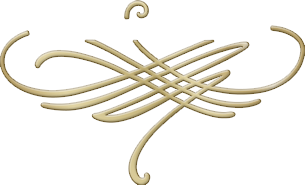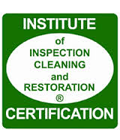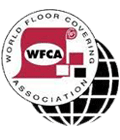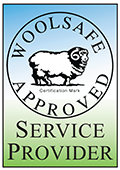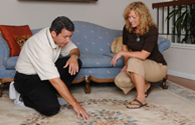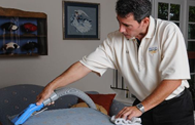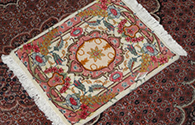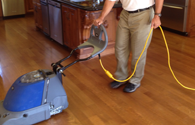Spots and Spills
A good checklist to handle spills should include the following items. Do not use any household cleaners other than those listed, since many household products contain chemicals that may permanently damage your carpet.
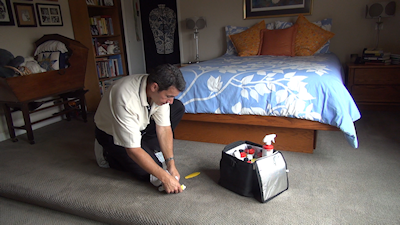
- A solution of a mild liquid detergent.
• No more than 1/4 teaspoon of detergent to 32 ounces of water.
• A clear, non-bleach liquid dishwashing detergent such as Dawn, Joy, or clear Ivory is recommended.
• Do not use detergents that are cloudy or creamy because they may leave a sticky residue. - A solution of 1 part white vinegar to 1 part water.
- White cloths or white paper towels.
- An ammonia solution of one tablespoon of ammonia to one cup of water.
Do not use on wool. - Non-oily nail polish remover
- Chewing gum remover (freeze or solid type).
- Spot remover specifically for grease, oil, or tar, such as Carbona or Energine.
NOTE: Difficult stains on carpets made from solution-dyed fibers such as polypropylene may be removed with a mild bleach solution ( one part chlorine bleach to five parts water).
WARNING: Do not use bleach solution unless you are absolutely certain your carpet is 100% solution dyed. Carpet dyed by other systems will be damaged. If in doubt, call 408-448-2016
General Instructions
- Prompt attention to spots and spills is essential. No carpet is stain proof, although many are stain resistant, which allows time to act.
- Remove as much of food spills as possible by scraping gently with a spoon or dull knife.
- Absorb wet spills as quickly as possible by blotting repeatedly with white paper or cloth towels.
- Always blot, never rub or scrub abrasively, as a fuzzy area may result. When blotting, work from the outer edge in toward the center of the spot to avoid spreading the spill.
- Always follow up with water to remove detergent residue that may become sticky and cause rapid re-soiling.
- Draw out any remaining moisture by placing several layers of white towels over the spot and weigh them down with a heavy object that will not transfer color such as a plastic jug of water.
What did you spill?
| Stain | Removal |
|---|---|
| Alcoholic Beverages | A |
| Asphalt | B, PRESTIGE |
| Beer | A |
| Betadine | PRESTIGE |
| Berries | A |
| Blood (wet) | A |
| Blood (dry) | A-2 |
| Butter | B |
| Chewing Gum | C |
| Chocolate | A-2 |
| Coffee | A-1 (D if necessary) |
| Cola Drinks | A |
| Cosmetics | A (D if necessary) |
| Crayon | B |
| De-icer (Calcium Chloride) | Vacuum, A |
| Excrement | A |
| Food Dyes | A |
| Furniture Polish | B, PRESTIGE |
| Glue (white) | A |
| Gravy | A |
| Grease (Auto) | B, PRESTIGE |
| Grease (Food) | B |
| Ice Cream | A |
| Ink (Ballpoint) | B, PRESTIGE |
| Ink (Permanent) | B, (D if necessary) |
| Ink (Washable) | A, PRESTIGE |
| Jelly | A |
| Lipstick | B |
| Milk | A |
| Mud | A |
| Mustard | A, (D if necessary) |
| Nail Polish | Polish Remover |
| Paint (Latex, wet) | A |
| Paint (Latex, dry) | B |
| Paint (Oil) | B, PRESTIGE |
| Rust | PRESTIGE |
| Shoe Polish | B |
| Tea | A. (D if necessary) |
| Urine | A-1, PRESTIGE |
| Vomit | A-1 |
| Wa x | C |
| Wine | A-2 |
Removal Procedures
Find your spill in the chart.
The following recommendations should be used for spot cleaning. All instructions should be used in the recommended sequence below. Some stains are marked "PRESTIGE", indicating that professional knowledge and equipment are necessary.
-
A: Water Soluble Stains
Absorb as much as possible with white towels. Blot the stained area with white towels dampened with cool water until there is no more transfer of the stain onto the towels.
If any of the stain remains, use the detergent solution previously described. Spray lightly onto the spot and blot repeatedly with white towels, working from the outer edge in toward the center of the spot to avoid spreading.
Rinse thoroughly by spraying with clean water, then blot or extract, do not use too much detergent because the residue will contribute to rapid re-soilingA-1. As in A, but before using detergent, apply the white vinegar solution to a white towel and blot or spray onto spot.
A-2. As in A, but before using detergent, apply a house-hold ammonia solution to a white towel and blot or spray onto spot. Do not use on wool or wool-blend carpet. Rinse as in A.
-
B: Oil-Based Stains
Blot as much as possible with white paper towels. Apply the special oil and grease spot remover to a paper towel and repeat blotting. (protective gloves should be worn, as the solvent will quickly remove oils from the skin and could result in irritation.) Do not pour or spray directly on the carpet pile, as damage to the backing or adhesive underneath could result; use the towels to transport the solvent to the carpet. Repeat as often as necessary.
Provide adequate ventilation! Do not use flammable solvents! Follow with procedures in A. -
C: Chewing Gum and Candle Wax
Freeze with ice or a commercially available product in an aerosol can. Shatter with a blunt object, and vacuum before the chips soften. Follow up with solvent as in B. -
D: Stains that respond to Bleach solution
Mild bleach solution:
(one part chlorine bleach to five parts water).
WARNING: Only carpets which are solution dyed are resistant to bleaching, but do not exceed the recommended concentration. DO NOT USE THIS PROCEDURE UNLESS YOU ARE ABSOLUTELY CERTAIN THE CARPET IS SOLUTION DYED - CARPETS DYED BY OTHER SYSTEMS WILL BE DAMAGED. Products with olefin and nylon blends can not be exposed to bleach without removing the color from the nylon fibers unless the nylon component is solution dyed.
If in doubt, call 408-448-2016.
PRESTIGE -- Bill Corridan, Prestige Carpet & Upholstery Cleaning 408-448-2016
Improving Your Indoor Environment
During the 1960's and 1970's, much of our nation's focus was on the pollution of our outdoor environment, but recently our focus has shifted to pollution of our indoor environment.
Concern for fuel economy in the early 1970's led to changed in construction techniques and building design to prevent the loss of temperature-controlled air from buildings. Airtight structures keep air inside, but they also prevent the flow of fresh air from outside. Research by the Environmental Protection Agency (EPA) has determined that our indoor environment has two to five times more pollutants than outside air.
The quality of our indoor air has become more important to us in recent years in that the average American spends over 20 hours a day inside a closed structure. We spend 90 percent of our lives indoors. Heightened consumer healthy awareness has placed an emphasis on improving the quality of our indoor environment.
Carpet plays a vital, positive role in indoor air quality. It acts as an environmental filter, trapping and holding impurities from the air we breathe. The EPA and carpet industry findings indicate that the proper ventilation of new carpet, carpet itself does not contribute negatively to indoor air quality. But, the buildup of soil in carpet does. Upholstery fabric also harbors soil and contaminants.
According to Michael A. Berry, Ph D, former Deputy Director of the EPA Environmental Criteria and Assessment Office, the single leading cause of poor indoor air quality is build environments today is poor maintenance. Carpet and upholstery must be cleaned to remove trapped contaminants before they overflow and are released back into the indoor air.
For a healthier indoor environment, the Institute of Inspection, Cleaning and Restoration Certification (IICRC) recommends:
Vacuum frequently. A vacuum cleaner with a high efficiency filtration bag removes soils and biocontaminants from carpet and upholstery and reduces the release of respirable particles in the air. These bags are now available for most models of vacuum cleaners at retail stores that carry vacuum cleaners and accessories.
Periodically have carpet and upholstery professionally cleaned. Thorough cleaning removes soil and pollutants to improve air quality. Contact PRESTIGE Carpet and Upholstery Cleaning at 408-448-2016, a IICRC certified professional firm trained in the proper use of cleaning agents and equipment.
Control the sources
Entrance mats halt tracked-in soil and contaminants. Tobacco smoke, which is trapped in carpet and upholstery fabric, is a major source of indoor pollution.
Increase fresh air flow Our ancestors knew what they were doing when they opened windows to air out buildings.
Clean for Health Carpet and upholstery fabric hide soil. Don't just clean for appearance when the accumulation of soil becomes visible.
Prestige Offers These Services
Carpet
Cleaning
Even in the best kept homes, your quality carpeting requires periodic professional cleaning to maintain its like-new condition. Tracked-in soil, body oil from feet, and spots and spills require the attention of a specialist.
Upholstery
Cleaning
Upholstered furniture needs periodic professional cleaning. Spots, spills, and transferred body oils become noticeable and detract from the furniture’s original beauty.
We also clean outdoor furniture cushions.
Oriental Rug
Cleaning
We take special care with area rugs which also need periodic cleaning. Keep your area rugs in bright, clean, healthy condition with a professional cleaning.
Hardwood Floor
Cleaning
Preserve the beauty and life of your hardwood floors. With professional maintenance you can double or triple the life of your floors before they need refinishing. We can deep clean your floors and apply a preservation coating that maintains the integrity of and protects your original finish.

